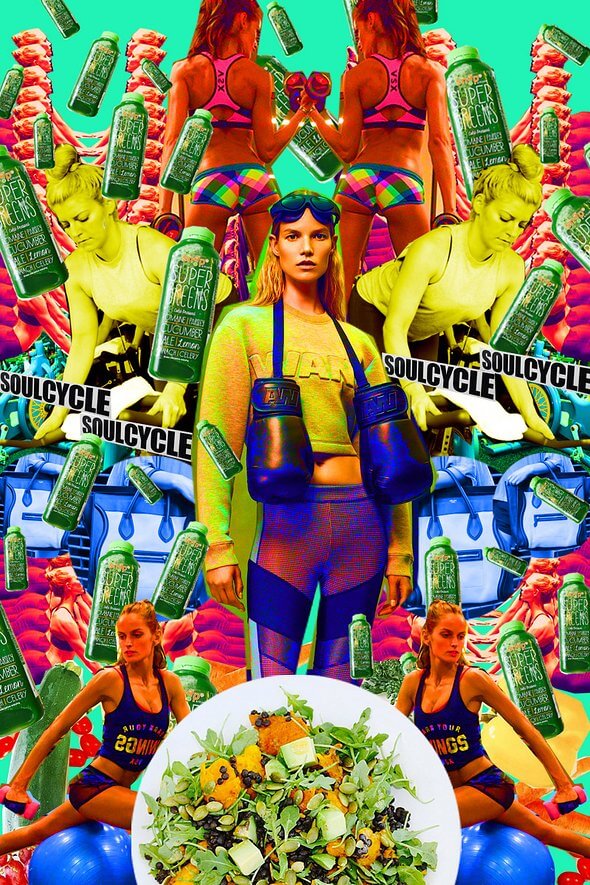Art by Marites Algones.
Article courtesy of Vogue.
Wellness, as any SoulCycle devotee will tell you, doesn’t come cheap these days. There are the weekly classes at $30 a pop, the $180-a-month gym membership, the daily $10 cold-pressed green juice, the pricey all-natural and organic skincare products, and the piles of fresh produce and hard-to-find supplements from Whole Foods…not to mention some of the more extravagant options out there ($500-an-hour trainers, $750 facials) and the sporty designer duds to complete the look. For most people, spending so much on staying fit and healthy would be a preposterous indulgence, but for a growing percentage of individuals with high discretionary income, wellness has become an important part of the luxury lifestyle.
Wellness has become an important part of the luxury lifestyle.
When the recession hit in 2008, luxury shoppers became more reluctant to purchase goods that actively flaunted their wealth. The phenomenon, dubbed “stealth wealth,” ushered in an era of discreetly luxurious brands like The Row and Céline, and a label-less, unadorned aesthetic that made it harder (to the uninitiated) to gauge how much a garment or handbag actually cost. Now, a few years after the recession, it seems there has been another shift, as luxury consumers pour their money into boutique fitness classes and expensive sportswear. If five years ago it was a Céline bag, today’s ultimate status symbol might just be a SoulCycle hoodie and a green juice.
“It’s become very much a brand in itself, the kind of sport and exercise you do,” says Candice Fragis, senior buyer at Net-a-Sporter, Net-a-Porter’s recently launched luxe activewear arm. “People are proud of it. They’re not just going to Barry’s Bootcamp or SoulCycle or SLT, they’re wearing the T-shirts.”
“It’s like the only acceptable lifestyle brag,” says Ana, 26, a Manhattan spinning enthusiast. “You are a douche if you brag about your car or how much money you make, but bragging about how much you spin is normal, though still very annoying.”
Your fitness regimen of choice says a lot about you. And just like there are Smart Car types and Porsche types, there are yoga types and boot camp types; exercise has become another arena to compare and contrast your personality and lifestyle with others.
“It’s a social topic,” says Fragis. “People talk about where they’re going on holiday or what new restaurant they’ve tried. Now they also talk about what new classes they’re taking.”
Eating right can give the privileged class a sense of moral superiority.
Getting the body you want might be the end goal, but for some, membership alone might be enough. “Feeling like you’re part of an elite group—that’s a huge purchase motivator,” says Larry D. Compeau, professor of marketing and consumer psychology at Clarkson University. It’s the reason why American Express’ Black Card program has been such a success. “It’s about being in a club,” adds Compeau.
There are other factors as well. With income inequality at an all-time high and obesity rates continuing to spike among lower-income
individuals—even as this wellness culture flourishes—eating right can give the privileged class a sense of moral superiority. Not that shopping at Whole Foods and going to spin classes make you morally superior, but they won’t likely make you look or feel bad in the company of the less fortunate. “When you spend big bucks on experiences that supposedly are good for you, there seems to be less guilt than when it is just a physical luxury item,” explains Compeau. “Spending $10,000 on a handbag might prompt significantly more awareness of the purchase and consumption being more ostentatious than if the same amount was spent on an exclusive gym membership or exercise classes.” Recent studies show that wealthy Americans are still reluctant to engage in conspicuous consumption. A poll conducted by American Express Publishing and Harrison Group found that only one-third of rich Americans want to be viewed as such. “Since the recession there’s been some return to that kind of conspicuous consumption, but it’s nowhere where it used to be,” says Compeau.
The green juice is a display of wealth, discipline, and responsibility.
Compeau also points out that the wellness boom might be an extension of a larger consumer trend: “Since the recession there’s been less of an emphasis on things, and a greater emphasis on experiences. So we see people with means also engaging in extreme vacations and paying more for these extravagant experiences, which might be travel, private flying, or an expensive hobby.” And for the fashion set, it gives you a reason to wear the new Alexander Wang x H&M collection.
“Juices and juicing—and green juices in particular —are definitely a status symbol today,” says Charlotte Biltekoff, author of Eating Right in America: The Cultural Politics of Food and Health. “The green juice, for example, is a display of wealth, discipline, and responsibility—all of which, taken together, reflect and express status.”
Besides a conversation-worthy experience and the obvious health benefits, engaging in health and particularly fitness activities offers high-income individuals the rare chance to disconnect without feeling guilty. “Most people are connected 24/7 to their jobs,” says Compeau. “But for that hour you’re in the gym or in a class, you get to turn your phone off or put it away. And it’s not like your boss can ask you to be available during that.”
And in today’s work-obsessed culture, that might be the ultimate luxury.

